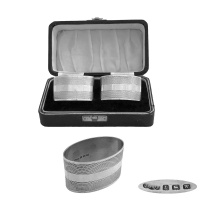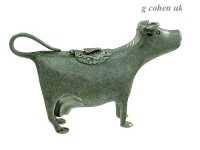Silver Hallmarking
A Brief History of Antique Silver
The British Hallmarking system has protected the consumer for over 600 years.
When silversmiths first started working with silver they discovered that it was far too soft to work with and had to be mixed with other, harder base metals before it could be worked. It is due to this discovery that from the year 1300 all silver metals had to be tested to show that they contained more than 92.5% silver. There was a brief period, from 1697 until 1720 when it was a statutory requirement for silver to be 95.8% pure (known as “Britannia standard”). Britannia standard has remained in use to this day, but as an option rather than a requirement.
The hallmarking system has survived to the present day without much change. It is these hallmarks that provide silver collectors with their most important identification tool. Hallmarks are stamped by the official assay offices, together with the maker's own mark, so you can identify where, when and who made the pieces of silver.
The word hallmark is derived from London’s Goldsmiths’ Hall of the Worshipful Company of Goldsmiths, the originator of Britain’s first hallmarks, which still maintains a record of all British hallmarks.
All solid silver that has been registered in this country should carry assay marks (the word assay is the same as the French essayer, to attempt or try). These marks ensure that the silver was tested to see if it met British laws for silver purity and quality. This mark varies according to the location of the assay office. London, for example, uses a Leopard’s head.
Apart from assay marks, there will also be a date mark and in some cases a duty mark to indicate that a relevant tax had been paid too. The duty mark was the head of the sovereign of the day. Typically a single piece will carry a Sterling guarantee (the lion), a town mark from where it was assayed (Anchor, Crown, Castle etc.) a date letter (normally in a shield, circle or square) to identify the year of Assay (A-Z or a-z) and a makers mark (typically some initials such as HP&S, R.B etc.)
From 1 January 1999 new European legislation has brought the British hallmarking system in line with the rest of Europe. Until then, only wares containing a minimum of 925 parts per thousand of pure silver were hallmarked and allowed to be referred to as solid silver. This new legislation allows a wider range of purity to be marked in the UK as silver. This means that a lower grade of silver (800) can also be marked in this country. Any "silver" without a suitable Sterling Guarantee hallmark should be treated as "white metal" as there is no guarantee as to how much silver the metal contains.
![]()
A typical set of hallmarks.
In this case, reading from left to right, we have the maker, John Emes, the lion passant, which is the guarantee of sterling standard, the leopard’s head (in this case crowned although the crown was removed after 1820) tells us that it was made in London, the letter “C” is the date- 1798- and the sovereign’s head, in this case George III. The head of the sovereign, usually known as the duty mark, showed that the silversmith had paid tax to the crown. This duty was no longer payable after 1890.
Every year was given it’s own date letter usually progressing in the order of the alphabet, as in London, but not always, as in Birmingham. Each cycle was in a different style or font, sometimes upper case and sometimes lower, in order to distinguish between periods. For the same reason the shield that enclosed the date letter also varied between cycles.
Manufacturers.
There are many learned works available to help identify manufacturing silversmiths through their maker’s stamp but a very useful online resource is www.silvermakersmarks.co.uk








.jpg)
(1).jpg)
(2).jpg)

.jpg)
.jpg)
(1).jpg)
.jpg)
(1).jpg)


.jpg)